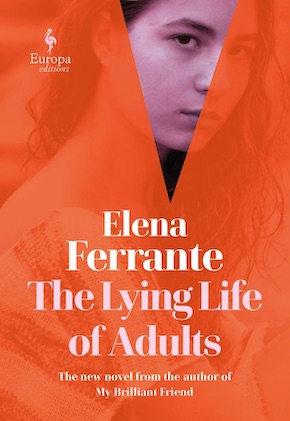Distant echoes of a mighty paean
by Mika Provata-Carlone
“Captures the interior states of young people with an unflinching psychological honesty that is striking in its vividness and depth.” The New York Times
Readers long spellbound by Elena Ferrante’s Valhalla-like worlds of the Italian South, her redoubtable skills as a writer, the swarming opacity of the mystery that enshrouds her, her ‘voice’, defying every categorisation, or even personification, will instantly pick up the familiar echoes and sounds of her previous books as they leaf through the pages of this brand new, yet-again-Neapolitan novel. There is the elusive, decentred narrator, the relentless sabotaging of the notion of a centre of being, of consciousness, of self and identity; the rites of passage as girls grow into women. There is the sub-narrative of female agency and femininity, of the attachment, or the insoluble rift, between parents and children, men and women, the I and the Other. There is, yet again, the even more explicitly proclaimed, starkly pictorial backdrop of high culture and popular myth-making, the eternal debacle between formal education and life experience, the art and artifice of intellectual finish and polish, and the purported genuineness of a more chthonic realm of human instinct and emotion. There are books, above all, and behind everything, the double-entendre of a life gloriously written, and a life that is a constant illusion, an entrapping vicariousness. There is the socio-ethnography of a new modernity encrusted on old, decrepit ruins, of money and the lack of it, of power and helplessness. Every page is full of Ferrante’s favourite game of putrefying shadows and electrifying light, it is full of the tensions around presence and erasure, cruelty and tragedy. The Lying Life of Adults is full of echoes of the most poignant of Ferrante’s themes and motifs, of almost all of her thunderous darkness. It is especially full of that special paradox that is particularly her own: the neck-breaking speed and thrust of stagnation and limbo.
In this new effort to speak the unspeakable, to capture the echoes of silence, to master the ineluctability of time, and of public and private history, what is new is precisely what has always been already there. Ferrante’s genius is that she sees the uniqueness of the mundane and the trivial, that she can put her finger on the minutiae from which world-shattering causalities begin. She knows how to translate private into public, how to amplify the factors of harmony and dissonance, how to strip bare our very soul, even as she claims to doubt its mortal or immortal existence.
Translation is key, both in Ferrante’s own ongoing project of transcribing and transposing a particular segment of humanity, which she succeeds in keeping both distinctly idiosyncratic and idiolectic, as well as rendering it archetypally universal, and in the English reincarnation of her text. Ann Goldstein has created for herself an inalienable space as the translator who can creatively reanimate, and not just convey, words, voices and cultural intangibles across languages, and her strengths seem to grow with each encounter with the author with whom she may be said to have become almost synonymous. The familiar Neapolitan lilt and idiom permeates this new novel as much as the previous ones, as do the shocks and jolts of a vocabulary of sheer violence, of an uncensored verbal punch that more often howls or yawps than speaks. There are only a few hiccups, as in the case of the effort to render the Italian ma che peccato, which is reduced to only one definition, sin, rather than the twofold sin/shame, which would have better captured the new conundrum Ferrante introduces in this novel, namely the sense of magnitude, morally catastrophic magnitude, in seemingly small acts of either outright unkindness or mere idiocy.
Ferrante’s genius is that she sees the uniqueness of the mundane and the trivial, that she can put her finger on the minutiae from which world-shattering causalities begin.”
As in her other works, here too Hell is not so much other people, pace Sartre; we ourselves are Hell, in our most intimate and controversial versions, in our darkest, most self-loathing and self-destructive, most maddeningly convoluted manifestations. Ferrante’s cosmology is made up of infinite, densely populated, yet chillingly alienated constellations, and this new story is no different. Here, the totalising non-verbal language of photographs, of lives that have been edited out of existence, of palimpsests of genealogies, lines of heredity, of beauty and ugliness, good and evil, whose weight defies any Atlas-like powers, aims for a character analysis and a social anatomy that concentrates on the bare essentials: parents and children, extended families, friendship and relationships between couples, namely the core social nuclei that make or break our world. The distortive lens of children, the dire difficulty of parents to convey reality or the warmth of security in its deepest and most essential form, the sense of freedom that so crucially depends on genuine attachment, the terrible, terrifying risk of losing a child’s affection, or of being cut off from a familial circle, together with the critical forces of influence, manipulation, domination, these are typical Ferrante themes. Here, too, they are vested in the typical (by now) conceit of a Pinter-like dynamics of reversed master and servant roles, or of provocative recalibrations of upper and lower, pure and impure, innocent and brutal, human and bestial. As ever, Ferrante generously sprinkles the story with tempting red (or otherwise hued) herrings, that may, or cannot possibly be autobiographical.
The focus in The Lying Life of Adults is unrelentingly close – obsessively minute. So much so that it seems to blur out of clarity, creating a hybrid fictional reality, where women’s voices are no longer female, and men’s sentiments cause an almost reeling sensation of superimposed images and symbols. Ferrante likes hyperbole, as well as clichés of a brutal carnality, which here finds a particularly morbid expression with an emphasis on self-loathing, on a revulsion of the erotic, unless it is either coyly auto-erotic or rather chocolate-box homoerotic. Men are either grossly repulsive, or sublimated intellects, beyond reach or even desire, whereas women are simply the other that is merely the same, which may (or may not) raise questions. The dysfunctionality of relationships is here used to propel a familiar Ferrante schema of transgression, that of ‘bestial poverty’ vs. ‘over-refined and over-bred wealth and respectability’, with the undercurrent of degeneracy, decadence and perversion, or of existential vacuity always just below the surface. The explicit interplay between black irony and deliberate unreliability sustains the reader’s interest, although there is a genuine sense of perplexity as to the effectiveness and ultimate point of many of the narrative threads and complications.
A ‘from Hell to Redemption’ pattern emerges at some point along the way, in the form of a wise priest, a handsome young man who has risen out of the gutter, Cronin-like, and is now looking at the stars; a buxomly cantankerous and rather spiteful aunt, who stands for temptation of all sorts; and the Bible, which is set up as the text to lead Giovanna, the central character and single voice in the novel, beyond the figments of fiction and into the realm of the credo quia impossibile est, whatever that belief may ultimately turn out to be. No mysticism emerges from the heady mix of tenuous reflection and even more tenuous sexual action. There is a powerful ambition to turn the narrative into an essay on self-fashioning (another Ferrante topos), on self-prostitution in the broader sense (of the body, rather graphically, but more critically of the mind and of the soul), on an assessment of the value and weightiness of roots and origins, of the debt one owes to oneself as well as to others, yet the edifice does not altogether hold either its shape or its ground. Without the sense of a parallel sociohistorical becoming, a background of a longer, more complex, more polyphonic and multilateral perspective, the novel, once any psychological interest is exhausted, falters with a sense of repetition and echo-chamber discomfort, of circularity and perhaps even triviality, certainly with a tinge of juvenile pathos (or, at some level, bathos, as the self-proclaimed record of “the arduous approach to the adult world”).
“Compunction”, we are told, is the word spoken by the voice in the wilderness that leads Giovanna out of her real and existential desert. It would have made for an extraordinary exploration of the human psyche, of society, of the potential itself of existence, had Ferrante not somehow skidded on the surface of her own, undeniable brilliance. In the end, The Lying Life of Adults is perhaps yet another instalment of “the ugly Naples… the terrible Italy” saga, a tactile ‘rough guide’ to new (or old) Neapolitan landscapes. On a more positive note, it may perhaps be seen as an imperfect fable on one of these now famous neighbourhoods, Posillipo, or at least on the meaning of its original Greek name: Pausilyponwas celebrated as a place of breathtaking, soul-changing beauty, a place that could restore a broken life. A pause to sadness? An end to misery? A respite from pain? Ferrante, as usual, is ever ambiguous on this, as on so many other points…
Elena Ferrante is the author of The Days of Abandonment (2005), Troubling Love (2006), The Lost Daughter (2008), and the four novels known as the Neapolitan Quartet (My Brilliant Friend, The Story of a New Name, Those Who Leave and Those Who Stay, and The Story of the Lost Child), which were published by Europa Editions between 2012 and 2015. The HBO series My Brilliant Friend, directed by Saverio Costanzo, premiered in 2018. Ferrante is also the author of Frantumaglia: A Writer’s Journey, the children’s picture book The Beach at Night illustrated by Mara Cerri (both 2016), and a collection of personal essays illustrated by Andrea Ucini entitled Incidental Inventions (2019). The Lost Daughter will be made into a feature film directed by Maggie Gyllenhaal and starring Olivia Colman. The Lying Life of Adults, translated by Ann Goldstein, is published by Europa Editions in hardback and eBook, and is being adapted by Netflix and Fandango.
Read more
elenaferrante.com
@EuropaEdUK
@EuropaEditions
Ann Goldstein was head of copy at the New Yorker until 2017. In addition to translating all of Elena Ferrante’s works, she has translated three books by Primo Levi and oversaw the publication of his Complete Works (Penguin Classics, 2015). The recipient of a PEN Renato Poggioli translation award and a Guggenheim Fellowship, her other translations include Jhumpa Lahiri’s Italian memoir In Other Words.
Mika Provata-Carlone is an independent scholar, translator, editor and illustrator, and a contributing editor to Bookanista. She has a doctorate from Princeton University and lives and works in London.
bookanista.com/author/mika/


